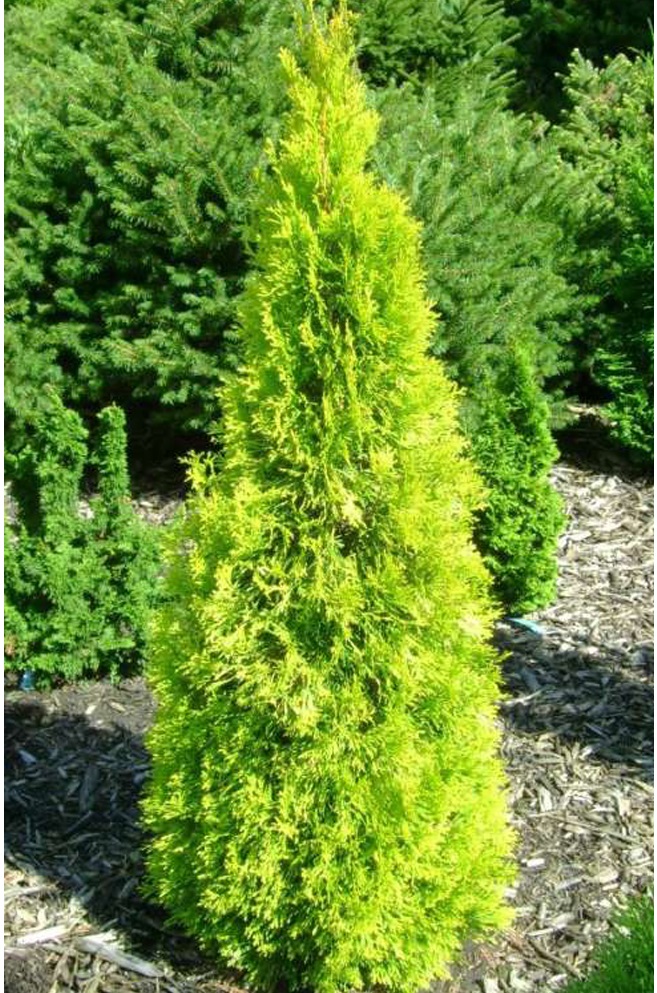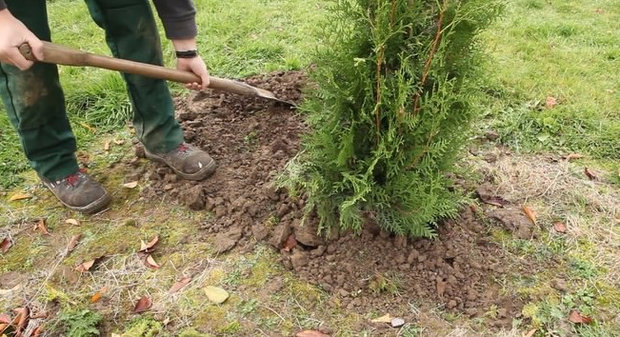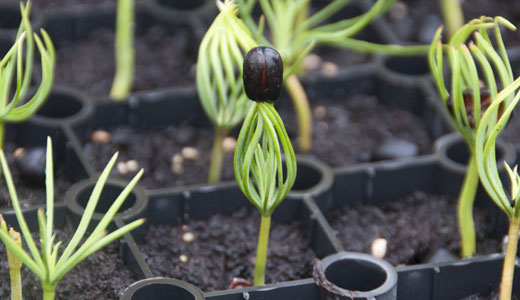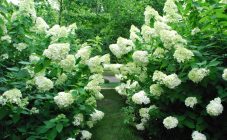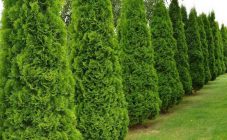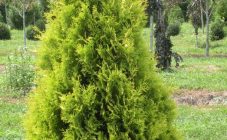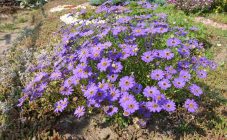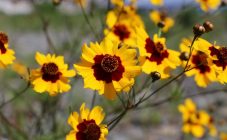Content:
Thuja western Golden Smaragd is one of the best decorative varieties of thuja. It is beautiful, grows slowly, has a small size, is unpretentious in care, it is easy to grow - this is what attracts gardeners when purchasing this plant.
Culture information
Thuja is an evergreen tree or shrub. In garden cultivation, its height does not exceed 11 meters, in natural conditions it is much higher. In young plants, the needles are light green, soft, needle-like, in adults, they are dark green, scaly.
Fruits in the form of small cones have an oblong or oval shape, they contain flat seeds. They ripen in the first year, in the fall. Thuja is grown in the open field. It can withstand urban smoke and is frost-resistant.
Description of thuja Gold Smaragd
This variety was bred by the Pole Edward Kubik, and after a ten-year trial in 2009 it was released on the market. Thuja has a beautiful color of needles: yellow-lime, on the tips - bright gold. Short shoots are densely arranged on the tree. Cones, oblong, small, no more than 1 cm long.
The shape of the thuja crown is pyramidal. The tree grows slowly, the annual growth is 10-20 cm. By the age of 10 years, the height of thuja Gold Smaragd reaches 2.5 m.An older plant is 5 m tall, the crown width at the base is 1.5 m.
Conditions for landing
Thuja can be planted in spring and autumn. If the tree is purchased in a container, then even at the beginning of summer. In autumn, the plant is planted as early as possible: it will take time to acclimatize. Planting in spring will give the plant more time for rooting, getting used to a new place of residence.
The landing site should be well lit by the sun. The tree tolerates shady and semi-shady areas, but the attractiveness of the crown will deteriorate. The needles do not suffer from sunburn, so an open area is suitable for thuja. One of the best characteristics of Golden Smaragd is that it can withstand the cold Russian winter conditions.
The soil is chosen light, loose, fertile. Thuja will grow best in a soil mixture of black soil, peat and sand. The acidity is preferable to neutral, but the plant will tolerate small deviations in one direction or another. With a close occurrence of groundwater, drainage, consisting of pebbles, broken shards, expanded clay, sand, is required.
Preparing for landing
The site must be prepared in advance. The planting hole should be 2-3 times larger in volume than the earthen lump.
Planting thuja Golden Smaragd step by step:
- the earthen lump is pre-watered, left to soak for 1 hour;
- a landing pit is dug;
- wakes up by half a soil mixture of peat, sand and black soil;
- the tree is placed in a hole, covered with the remaining soil;
- the earth is compacted, watered, mulched.
Sawdust, peat, humus are used as mulch. Thus, the root system of the thuja will be protected from overheating and drying out.In addition, the green space will receive additional nutrition from the decomposition of mulching materials.
Reproduction
In home gardening, thuja can be propagated in 2 ways: by seeds and cuttings. The seed method assumes, in turn, also 2 options: sowing directly into the ground or preliminary sowing of seeds for seedlings. Let's consider all the ways.
Seed in the ground
With this method, the seeds are harvested in the fall and sown immediately. No seed pretreatment is required. Shallow grooves are dug into which seeds are planted at a distance of 10 cm from each other. Then the planting area is mulched. In the spring sprouts will hatch.
Seed in seedling boxes
When planting thuja seeds for seedlings in boxes, they are pre-stratified. To do this, after harvesting in the fall, they are placed in the refrigerator for several months. This procedure will harden the seeds and destroy all diseases.
The process of sowing seeds step by step:
- before planting, after stratification, the seeds are soaked in water for 10 hours;
- drainage is laid at the bottom of the box, then the prepared soil mixture;
- the soil is leveled and compacted;
- shallow grooves are made, with an interval of 6-7 cm, a row from a row, into which seeds are sown;
- the grooves are slightly spilled with water, covered with soil mixture;
- the box is covered with glass or plastic wrap.
Until the seeds germinate, the box is kept in a warm place, then in a cool, but with good lighting. Seedlings should be ventilated every day. This growing method gives good germination.
Propagation by cuttings
The best time for reproduction of thuja Golden Smaragd by cuttings is summer, but only after the growth of shoots has stopped. For this, 2-3 year old growths are selected with a well-developed upper part of the tree (the middle one is not suitable - the plants can grow curved). The selected shoot comes off abruptly with a piece of bark (heel). All needles are removed from its lower part in order to avoid decay.
Step-by-step instructions for planting a cutting are as follows:
- the lower part of the cutting is processed in a growth stimulator;
- then it is inserted into the pot to a depth of 2 cm at an angle of 45 ° into the prepared soil;
- the earth is compacted and watered with warm, settled water;
- the pot is covered with a cut off plastic bottle or plastic wrap.
The mini-greenhouse must be ventilated every day. When young shoots begin to appear on the handle, this will mean that the seedling has begun. It is left to grow in the same container. After a year, the stalk rolls over together with the earthen lump into a container of large volume, and only after 2 years it can be planted in a permanent place in the garden.
Care
Thuja western variety Golden Smaragd loves moisture. The preferred watering regime is once a week. With long-term drought, the needles can dry out and lose their aesthetic appearance. Sprinkling over the crown can be done periodically. This removes dust and small insects.
Sanitary pruning is done regularly. This removes dry, damaged, diseased branches. Whether to carry out a deeper pruning depends on the purpose of planting the thuja. If, for example, it is planted as a low hedge, then its top is periodically cut off. In this case, the distance between the thuja during planting should be at least 50 cm.
Several times a year, it is necessary to feed the thuja with complex fertilizers for conifers. The first time was in April, after leaving the dormant period. The second time - in May, the third - in August. In the first year of thuja's life, the fertilizer concentration should be halved.
Diseases and pests
Like every green space, thuja is exposed to various diseases and pests. Let's consider the main ones.
- Fungus. It is manifested by browning of the shoots and drying of the needles. The damaged branches must be removed and burned, then the Golden Smaragd should be sprayed with a fungicide, for example, Fundazol.
- False shield. These are small bugs sticking around the needles of plants. In this case, a tubercle in the form of scales is formed. Every spring, for prevention, you need to spray it with an insecticide, for example, Actellik.
- Thuvaya aphid. Best of all, the drug Karbofos fights this green pest that sticks to the shoots.
- Rust. It affects young plants. They can get sick from high humidity, dry air, lack of nutrition. As a preventive measure, in the spring, sprinkle with HOM, if the disease has spread too much, Fundazol. The diseased branches are removed and destroyed.
The use of thuja in landscape design
Thuya Golden Smaragd will look spectacular both as a single plant and in various groups. Next to it, you can place tall perennials (roses, dahlias), as well as low-growing annuals, for example, petunias.
Golden Smaragd is also used as a living fence. At what distance to plant thuja Smaragd from each other depends on the preferences of the gardener. If it is necessary to create a dense hedge, the distance is chosen in the range from 50 to 80 cm, more sparse - from 80 cm to 1 m.
In addition, conifers (Cossack juniper, compact pine, spruce, thuja) and other shrubs (hydrangea, boxwood, dicentra) are planted next to the thuja. Another use in the landscape is content in the form of various sculptures, which is achieved by cropping.
Having planted Golden Smaragd on his plot, the gardener will acquire a spectacular plant that delights with its golden needles for many years. In the best possible way, this thuja will fit into the design of the garden, beautifully set off adjacent plantings, and will also be a bright background for taller plants.
